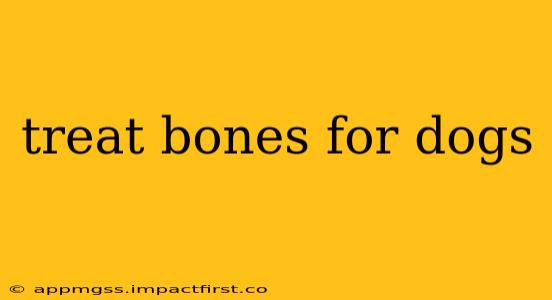Giving your canine companion a tasty treat bone is a fantastic way to keep them entertained, satisfy their natural chewing instincts, and even improve their dental health. However, choosing the right treat bone is crucial for their safety and well-being. This comprehensive guide will delve into the world of dog treat bones, addressing common questions and concerns to help you make informed decisions.
What are the best treat bones for dogs?
The "best" treat bone depends heavily on your dog's size, age, chewing habits, and any potential health concerns. Generally, you can categorize treat bones into several types:
-
Rawhide: While popular, rawhide chews can pose choking hazards if swallowed in large pieces, and some are treated with harsh chemicals. Always supervise your dog when they're chewing rawhide and opt for higher-quality, minimally processed options.
-
Nylon Bones: These are durable and long-lasting, making them suitable for aggressive chewers. However, they can break into sharp pieces, so careful monitoring is essential. Look for nylon bones that are designed to be safe and splinter-resistant.
-
Dental Bones: These are specifically designed to help clean your dog's teeth. They often have textures that scrape plaque and tartar, promoting better oral hygiene.
-
Real Bones: Never give cooked bones to dogs. Cooked bones splinter easily and can cause serious internal injuries. Raw, meaty bones (like marrow bones) can be excellent chews, providing nutrients and dental benefits, but always supervise your dog and be aware of potential risks. Choose appropriate sizes for your dog's breed and size.
-
Bully Sticks: These are dried beef pizzles that are highly digestible and provide a long-lasting chew. They're generally a safer alternative to rawhide, but still require supervision.
Are all treat bones safe for dogs?
No, not all treat bones are safe. Some can pose serious risks, including:
-
Choking hazards: Bones that break into small pieces can easily be swallowed, potentially leading to choking or intestinal blockage.
-
Dental damage: Hard bones can crack or break teeth.
-
Chemical treatments: Some rawhide and other chews contain chemicals that can be harmful to your dog's health.
-
Allergic reactions: Certain treat bones may trigger allergic reactions in some dogs.
Always choose treat bones from reputable brands and supervise your dog during chewing.
How do I choose the right size treat bone for my dog?
The size of the treat bone should be appropriate for your dog's size and chewing ability. A bone that's too small could be swallowed whole, while a bone that's too large could present a choking hazard or cause excessive strain on their jaw. Always choose a bone that's large enough to prevent swallowing but small enough to be managed comfortably.
What are the benefits of giving my dog treat bones?
Treat bones offer several benefits:
-
Dental health: Chewing helps remove plaque and tartar, promoting healthier teeth and gums.
-
Mental stimulation: Chewing is a natural behavior that keeps dogs entertained and prevents boredom.
-
Stress relief: Chewing can be a calming activity for anxious dogs.
-
Nutrient enrichment (with certain bones): Raw, meaty bones provide valuable nutrients.
How long should my dog chew on a treat bone?
This varies depending on the type of bone and your dog's chewing habits. Always supervise your dog and remove the bone if it becomes too small or if you notice any signs of wear and tear that could pose a choking hazard.
What should I do if my dog swallows a piece of a treat bone?
If you suspect your dog has swallowed a piece of a treat bone, monitor them closely for signs of distress, such as vomiting, diarrhea, or lethargy. If you notice any concerning symptoms, contact your veterinarian immediately.
By carefully considering these factors and choosing appropriate treat bones, you can provide your canine companion with a safe, enjoyable, and potentially beneficial chewing experience. Remember, responsible pet ownership includes mindful treat selection and constant supervision during playtime.
